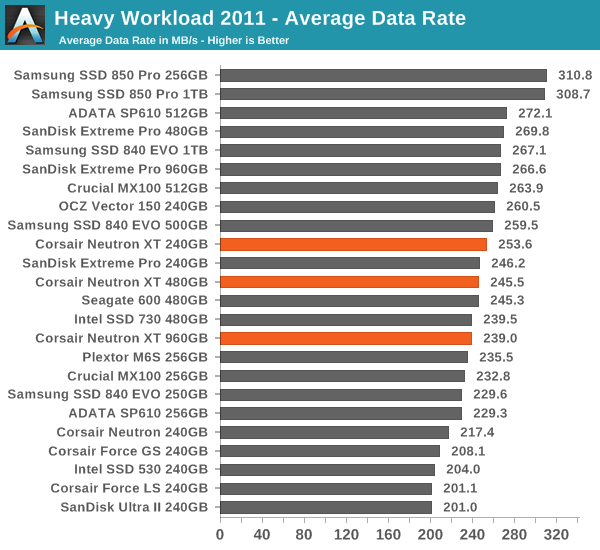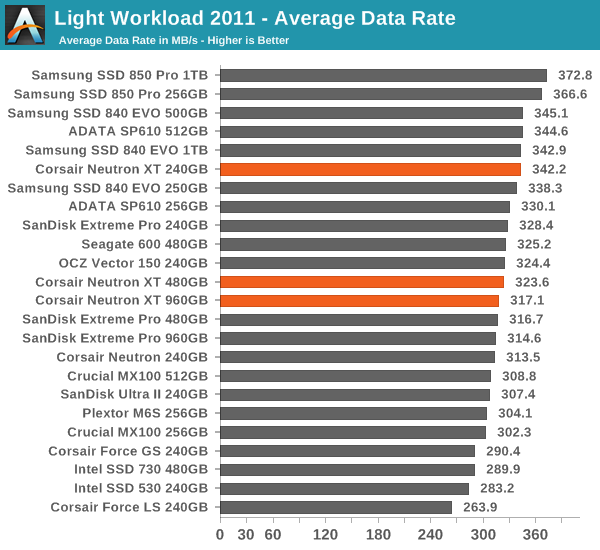Corsair Neutron XT (240GB, 480GB & 960GB) SSD Review: Phison S10 Debuts
by Kristian Vättö on November 17, 2014 9:00 AM ESTAnandTech Storage Bench 2011
Back in 2011 (which seems like so long ago now!), we introduced our AnandTech Storage Bench, a suite of benchmarks that took traces of real OS/application usage and played them back in a repeatable manner. The MOASB, officially called AnandTech Storage Bench 2011 – Heavy Workload, mainly focuses on peak IO performance and basic garbage collection routines. There is a lot of downloading and application installing that happens during the course of this test. Our thinking was that it's during application installs, file copies, downloading and multitasking with all of this that you can really notice performance differences between drives. The full description of the Heavy test can be found here, while the Light workload details are here.

The same story continues in our 2011 Storage Benches. The Neutron XT is an upgrade – and actually a fairly substantial one – from the Force LS, but it doesn't break any records. Also, what's a bit surprising is that the performance drops as the capacity increases because the 240GB is the fastest of the Neutron XT family. This isn't uncommon because the larger capacities have more LBAs to track, which requires more processing power for internal tasks, but it's still something that's worth noting.











56 Comments
View All Comments
magnusmundus - Monday, November 17, 2014 - link
I think the SATA 3 SSD market is already saturated. Read/write speeds and IOPS are pretty much as good as they are going to get. The only thing left to do is increase capacity and reduce costs. Why not start releasing drives for the new SATA Express interface, or more M.2 form factor drives? Too small a Z97 market? I guess we'll have to wait another year or so.sweenish - Monday, November 17, 2014 - link
I personally vote for skipping m.2 altogether. Let's just move right on to the PCI-E drives.TinHat - Monday, November 17, 2014 - link
+1hrrmph - Monday, November 17, 2014 - link
I think you mean let's skip the M.2 drives that use the (slower) SATA protocol, and move right on to the M.2 drives that use the (faster) PCI-E protocol.Samus - Monday, November 17, 2014 - link
Right. I have a Samsung M.2 PCIE drive, and after finally getting it to boot on my H97 board (using a EFI boot manager partition on my SATA SSD to point to its windows installation) all I can tell you is 1100MB/sec is pretty insane. It loads BF4 maps so fast I'm always waiting on the server...Mikemk - Monday, November 17, 2014 - link
So you want to lose a GPU?shank15217 - Tuesday, November 18, 2014 - link
The protocol is called NVMe, a PCI-E drive doesn't mean much.r3loaded - Tuesday, November 18, 2014 - link
Actually both the legacy AHCI and the new NVMe protocols can be used on a PCIe-attached drive. The consumer Plextor M6e and Samsung XP941 use AHCI for compatibility reasons, while the new Intel server drives use NVMe for better performance in server workloads.Kristian Vättö - Monday, November 17, 2014 - link
Every single controller house is working on a PCIe controller for SATA Express and M.2, but the development takes time.warrenk81 - Monday, November 17, 2014 - link
honest question, not trying to be snarky, but how has apple been shipping PCIe SSDs for almost two years and no one else is?